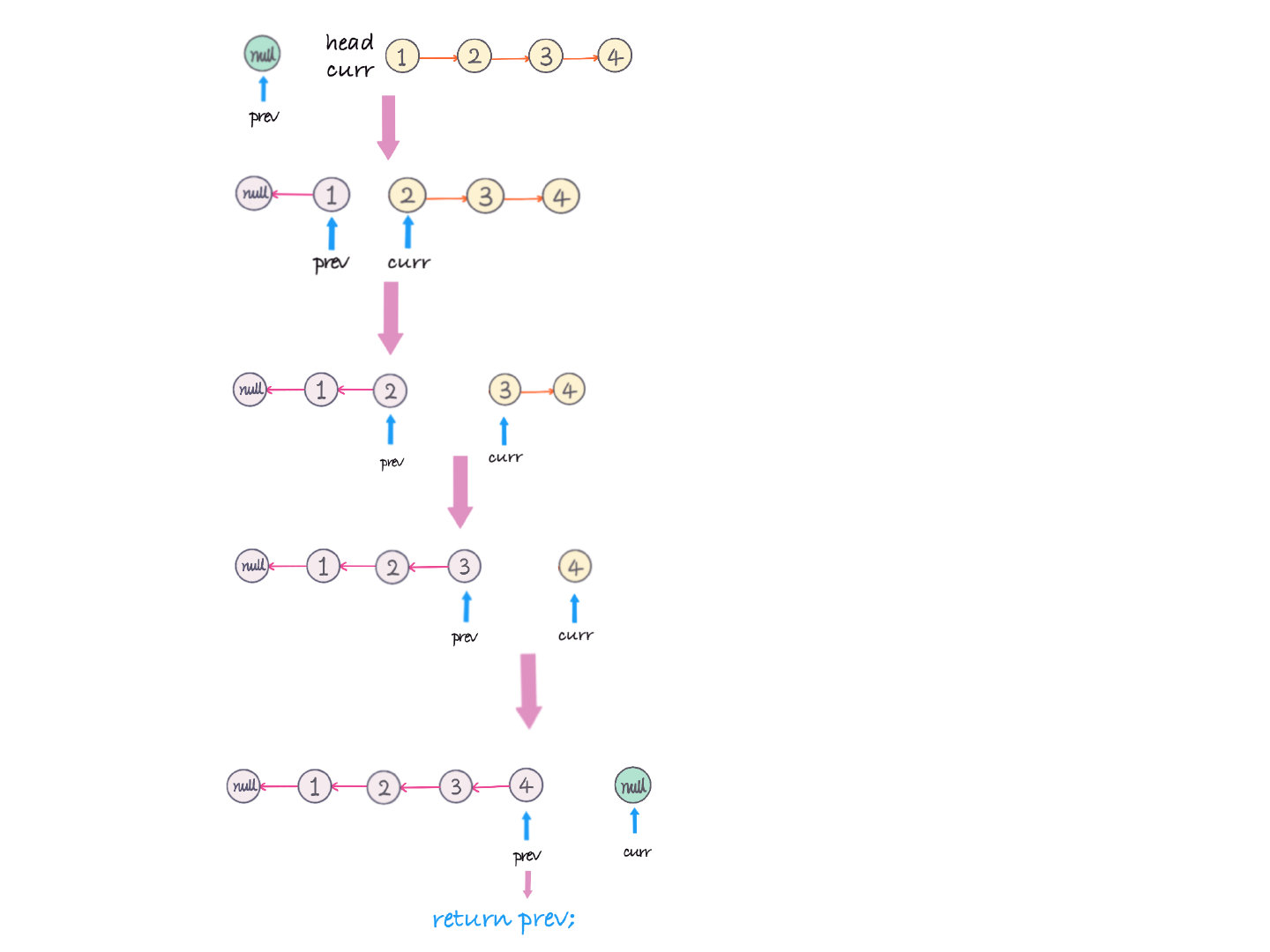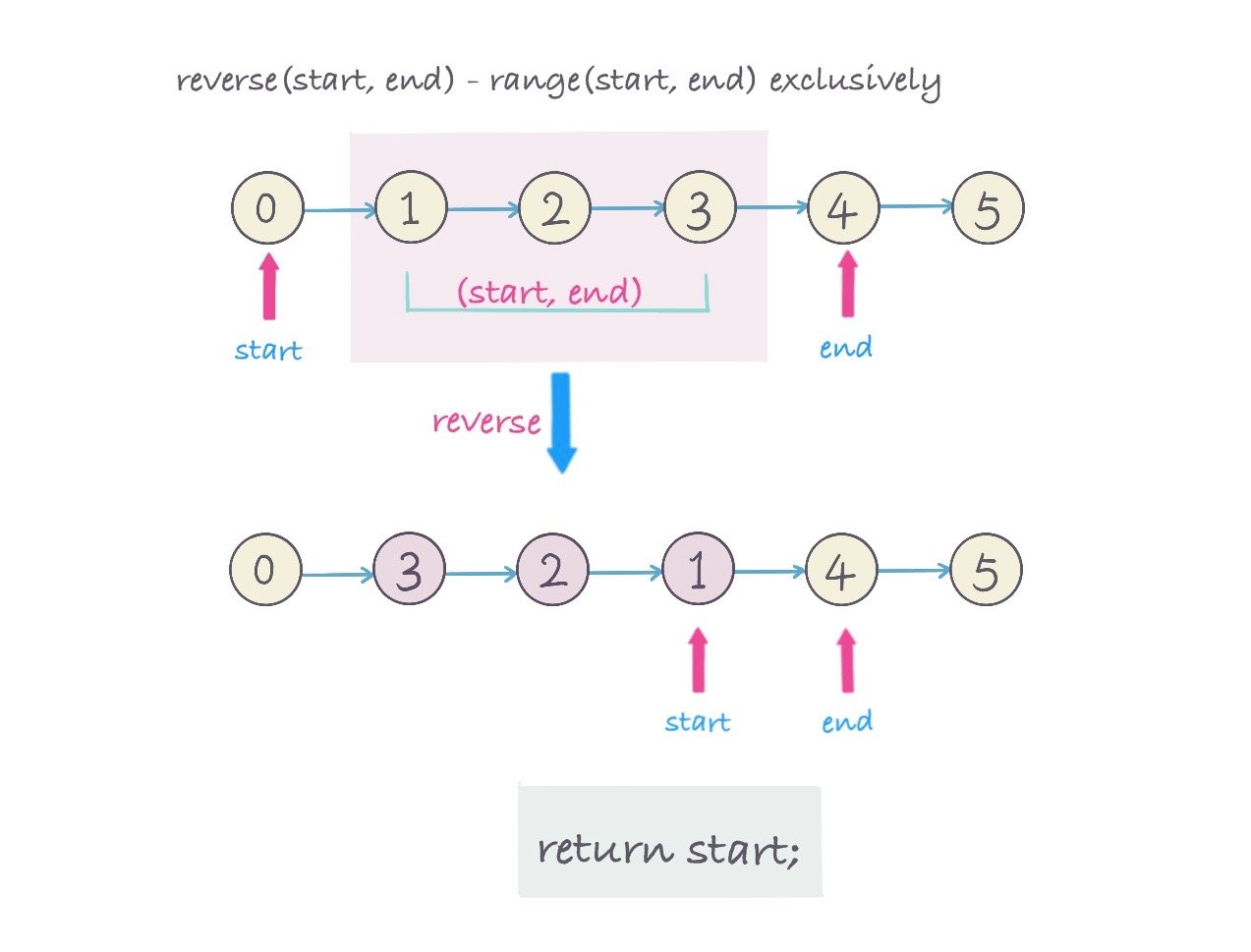# 0025. K 個一組翻轉鏈表
## 題目地址(25. K 個一組翻轉鏈表)
<https://leetcode-cn.com/problems/reverse-nodes-in-k-group/>
## 題目描述
```
<pre class="calibre18">```
給你一個鏈表,每 k 個節點一組進行翻轉,請你返回翻轉后的鏈表。
k 是一個正整數,它的值小于或等于鏈表的長度。
如果節點總數不是 k 的整數倍,那么請將最后剩余的節點保持原有順序。
示例:
給你這個鏈表:1->2->3->4->5
當 k = 2 時,應當返回: 2->1->4->3->5
當 k = 3 時,應當返回: 3->2->1->4->5
說明:
你的算法只能使用常數的額外空間。
你不能只是單純的改變節點內部的值,而是需要實際進行節點交換。
```
```
## 前置知識
- 鏈表
## 公司
- 阿里
- 騰訊
- 百度
- 字節
## 思路
題意是以 `k` 個 nodes 為一組進行翻轉,返回翻轉后的`linked list`.
從左往右掃描一遍`linked list`,掃描過程中,以 k 為單位把數組分成若干段,對每一段進行翻轉。給定首尾 nodes,如何對鏈表進行翻轉。
鏈表的翻轉過程,初始化一個為`null`的 `previous node(prev)`,然后遍歷鏈表的同時,當前`node (curr)`的下一個(next)指向前一個`node(prev)`, 在改變當前 node 的指向之前,用一個臨時變量記錄當前 node 的下一個`node(curr.next)`. 即
```
<pre class="calibre18">```
ListNode temp = curr.next;
curr.next = prev;
prev = curr;
curr = temp;
```
```
舉例如圖:翻轉整個鏈表 `1->2->3->4->null` -> `4->3->2->1->null`

這里是對每一組(`k個nodes`)進行翻轉,
1. 先分組,用一個`count`變量記錄當前節點的個數
2. 用一個`start` 變量記錄當前分組的起始節點位置的前一個節點
3. 用一個`end`變量記錄要翻轉的最后一個節點位置
4. 翻轉一組(`k個nodes`)即`(start, end) - start and end exclusively`。
5. 翻轉后,`start`指向翻轉后鏈表, 區間`(start,end)`中的最后一個節點, 返回`start` 節點。
6. 如果不需要翻轉,`end` 就往后移動一個(`end=end.next`),每一次移動,都要`count+1`.
如圖所示 步驟 4 和 5: 翻轉區間鏈表區間`(start, end)`

舉例如圖,`head=[1,2,3,4,5,6,7,8], k = 3`

> **NOTE**: 一般情況下對鏈表的操作,都有可能會引入一個新的`dummy node`,因為`head`有可能會改變。這里`head 從1->3`, `dummy (List(0))`保持不變。
#### 復雜度分析
- *時間復雜度:*`O(n) - n is number of Linked List`
- *空間復雜度:*`O(1)`
## 關鍵點分析
1. 創建一個 dummy node
2. 對鏈表以 k 為單位進行分組,記錄每一組的起始和最后節點位置
3. 對每一組進行翻轉,更換起始和最后的位置
4. 返回`dummy.next`.
## 代碼 (`Java/Python3/javascript`)
*Java Code*
```
<pre class="calibre18">```
<span class="hljs-class"><span class="hljs-keyword">class</span> <span class="hljs-title">ReverseKGroupsLinkedList</span> </span>{
<span class="hljs-function"><span class="hljs-keyword">public</span> ListNode <span class="hljs-title">reverseKGroup</span><span class="hljs-params">(ListNode head, <span class="hljs-keyword">int</span> k)</span> </span>{
<span class="hljs-keyword">if</span> (head == <span class="hljs-keyword">null</span> || k == <span class="hljs-params">1</span>) {
<span class="hljs-keyword">return</span> head;
}
ListNode dummy = <span class="hljs-keyword">new</span> ListNode(<span class="hljs-params">0</span>);
dummy.next = head;
ListNode start = dummy;
ListNode end = head;
<span class="hljs-keyword">int</span> count = <span class="hljs-params">0</span>;
<span class="hljs-keyword">while</span> (end != <span class="hljs-keyword">null</span>) {
count++;
<span class="hljs-title">// group</span>
<span class="hljs-keyword">if</span> (count % k == <span class="hljs-params">0</span>) {
<span class="hljs-title">// reverse linked list (start, end]</span>
start = reverse(start, end.next);
end = start.next;
} <span class="hljs-keyword">else</span> {
end = end.next;
}
}
<span class="hljs-keyword">return</span> dummy.next;
}
<span class="hljs-title">/**
* reverse linked list from range (start, end), return last node.
* for example:
* 0->1->2->3->4->5->6->7->8
* | |
* start end
*
* After call start = reverse(start, end)
*
* 0->3->2->1->4->5->6->7->8
* | |
* start end
* first
*
*/</span>
<span class="hljs-function"><span class="hljs-keyword">private</span> ListNode <span class="hljs-title">reverse</span><span class="hljs-params">(ListNode start, ListNode end)</span> </span>{
ListNode curr = start.next;
ListNode prev = start;
ListNode first = curr;
<span class="hljs-keyword">while</span> (curr != end){
ListNode temp = curr.next;
curr.next = prev;
prev = curr;
curr = temp;
}
start.next = prev;
first.next = curr;
<span class="hljs-keyword">return</span> first;
}
}
```
```
*Python3 Cose*
```
<pre class="calibre18">```
<span class="hljs-class"><span class="hljs-keyword">class</span> <span class="hljs-title">Solution</span>:</span>
<span class="hljs-function"><span class="hljs-keyword">def</span> <span class="hljs-title">reverseKGroup</span><span class="hljs-params">(self, head: ListNode, k: int)</span> -> ListNode:</span>
<span class="hljs-keyword">if</span> head <span class="hljs-keyword">is</span> <span class="hljs-keyword">None</span> <span class="hljs-keyword">or</span> k < <span class="hljs-params">2</span>:
<span class="hljs-keyword">return</span> head
dummy = ListNode(<span class="hljs-params">0</span>)
dummy.next = head
start = dummy
end = head
count = <span class="hljs-params">0</span>
<span class="hljs-keyword">while</span> end:
count += <span class="hljs-params">1</span>
<span class="hljs-keyword">if</span> count % k == <span class="hljs-params">0</span>:
start = self.reverse(start, end.next)
<span class="hljs-title"># end 調到下一個</span>
end = start.next
<span class="hljs-keyword">else</span>:
end = end.next
<span class="hljs-keyword">return</span> dummy.next
<span class="hljs-title"># (start, end) 左右都開放</span>
<span class="hljs-function"><span class="hljs-keyword">def</span> <span class="hljs-title">reverse</span><span class="hljs-params">(self, start, end)</span>:</span>
prev, curr = start, start.next
first = curr
<span class="hljs-title"># 反轉</span>
<span class="hljs-keyword">while</span> curr != end:
next = curr.next
curr.next = prev
prev = curr
curr = next
<span class="hljs-title"># 將反轉后的鏈表添加到原鏈表中</span>
start.next = prev
first.next = end
<span class="hljs-title"># 返回反轉前的頭, 也就是反轉后的尾部</span>
<span class="hljs-keyword">return</span> first
```
```
*javascript code*
```
<pre class="calibre18">```
<span class="hljs-title">/**
* @param {ListNode} head
* @param {number} k
* @return {ListNode}
*/</span>
<span class="hljs-keyword">var</span> reverseKGroup = <span class="hljs-function"><span class="hljs-keyword">function</span> (<span class="hljs-params">head, k</span>) </span>{
<span class="hljs-title">// 標兵</span>
<span class="hljs-keyword">let</span> dummy = <span class="hljs-keyword">new</span> ListNode();
dummy.next = head;
<span class="hljs-keyword">let</span> [start, end] = [dummy, dummy.next];
<span class="hljs-keyword">let</span> count = <span class="hljs-params">0</span>;
<span class="hljs-keyword">while</span> (end) {
count++;
<span class="hljs-keyword">if</span> (count % k === <span class="hljs-params">0</span>) {
start = reverseList(start, end.next);
end = start.next;
} <span class="hljs-keyword">else</span> {
end = end.next;
}
}
<span class="hljs-keyword">return</span> dummy.next;
<span class="hljs-title">// 翻轉stat -> end的鏈表</span>
<span class="hljs-function"><span class="hljs-keyword">function</span> <span class="hljs-title">reverseList</span>(<span class="hljs-params">start, end</span>) </span>{
<span class="hljs-keyword">let</span> [pre, cur] = [start, start.next];
<span class="hljs-keyword">const</span> first = cur;
<span class="hljs-keyword">while</span> (cur !== end) {
<span class="hljs-keyword">let</span> next = cur.next;
cur.next = pre;
pre = cur;
cur = next;
}
start.next = pre;
first.next = cur;
<span class="hljs-keyword">return</span> first;
}
};
```
```
## 參考(References)
- [Leetcode Discussion (yellowstone)](https://leetcode.com/problems/reverse-nodes-in-k-group/discuss/11440/Non-recursive-Java-solution-and-idea)
## 擴展 1
- 要求從后往前以`k`個為一組進行翻轉。**(字節跳動(ByteDance)面試題)**
例子,`1->2->3->4->5->6->7->8, k = 3`,
從后往前以`k=3`為一組,
- `6->7->8` 為一組翻轉為`8->7->6`,
- `3->4->5`為一組翻轉為`5->4->3`.
- `1->2`只有 2 個 nodes 少于`k=3`個,不翻轉。
最后返回: `1->2->5->4->3->8->7->6`
這里的思路跟從前往后以`k`個為一組進行翻轉類似,可以進行預處理:
1. 翻轉鏈表
2. 對翻轉后的鏈表進行從前往后以 k 為一組翻轉。
3. 翻轉步驟 2 中得到的鏈表。
例子:`1->2->3->4->5->6->7->8, k = 3`
1. 翻轉鏈表得到:`8->7->6->5->4->3->2->1`
2. 以 k 為一組翻轉: `6->7->8->3->4->5->2->1`
3. 翻轉步驟#2 鏈表: `1->2->5->4->3->8->7->6`
## 擴展 2
如果這道題你按照 [92.reverse-linked-list-ii](92.reverse-linked-list-ii.html) 提到的 `p1, p2, p3, p4`(四點法) 的思路來思考的話會很清晰。
代碼如下(Python):
```
<pre class="calibre18">```
<span class="hljs-class"><span class="hljs-keyword">class</span> <span class="hljs-title">Solution</span>:</span>
<span class="hljs-function"><span class="hljs-keyword">def</span> <span class="hljs-title">reverseKGroup</span><span class="hljs-params">(self, head: ListNode, k: int)</span> -> ListNode:</span>
<span class="hljs-keyword">if</span> head <span class="hljs-keyword">is</span> <span class="hljs-keyword">None</span> <span class="hljs-keyword">or</span> k < <span class="hljs-params">2</span>:
<span class="hljs-keyword">return</span> head
dummy = ListNode(<span class="hljs-params">0</span>)
dummy.next = head
pre = dummy
cur = head
count = <span class="hljs-params">0</span>
<span class="hljs-keyword">while</span> cur:
count += <span class="hljs-params">1</span>
<span class="hljs-keyword">if</span> count % k == <span class="hljs-params">0</span>:
pre = self.reverse(pre, cur.next)
<span class="hljs-title"># end 調到下一個位置</span>
cur = pre.next
<span class="hljs-keyword">else</span>:
cur = cur.next
<span class="hljs-keyword">return</span> dummy.next
<span class="hljs-title"># (p1, p4) 左右都開放</span>
<span class="hljs-function"><span class="hljs-keyword">def</span> <span class="hljs-title">reverse</span><span class="hljs-params">(self, p1, p4)</span>:</span>
prev, curr = p1, p1.next
p2 = curr
<span class="hljs-title"># 反轉</span>
<span class="hljs-keyword">while</span> curr != p4:
next = curr.next
curr.next = prev
prev = curr
curr = next
<span class="hljs-title"># 將反轉后的鏈表添加到原鏈表中</span>
<span class="hljs-title"># prev 相當于 p3</span>
p1.next = prev
p2.next = p4
<span class="hljs-title"># 返回反轉前的頭, 也就是反轉后的尾部</span>
<span class="hljs-keyword">return</span> p2
<span class="hljs-title"># @lc code=end</span>
```
```
**復雜度分析**
- 時間復雜度:O(N)O(N)O(N)
- 空間復雜度:O(1)O(1)O(1)
## 相關題目
- [92.reverse-linked-list-ii](92.reverse-linked-list-ii.html)
- [206.reverse-linked-list](206.reverse-linked-list.html)
大家對此有何看法,歡迎給我留言,我有時間都會一一查看回答。更多算法套路可以訪問我的 LeetCode 題解倉庫:<https://github.com/azl397985856/leetcode> 。 目前已經 37K star 啦。 大家也可以關注我的公眾號《力扣加加》帶你啃下算法這塊硬骨頭。 
- Introduction
- 第一章 - 算法專題
- 數據結構
- 基礎算法
- 二叉樹的遍歷
- 動態規劃
- 哈夫曼編碼和游程編碼
- 布隆過濾器
- 字符串問題
- 前綴樹專題
- 《貪婪策略》專題
- 《深度優先遍歷》專題
- 滑動窗口(思路 + 模板)
- 位運算
- 設計題
- 小島問題
- 最大公約數
- 并查集
- 前綴和
- 平衡二叉樹專題
- 第二章 - 91 天學算法
- 第一期講義-二分法
- 第一期講義-雙指針
- 第二期
- 第三章 - 精選題解
- 《日程安排》專題
- 《構造二叉樹》專題
- 字典序列刪除
- 百度的算法面試題 * 祖瑪游戲
- 西法的刷題秘籍】一次搞定前綴和
- 字節跳動的算法面試題是什么難度?
- 字節跳動的算法面試題是什么難度?(第二彈)
- 《我是你的媽媽呀》 * 第一期
- 一文帶你看懂二叉樹的序列化
- 穿上衣服我就不認識你了?來聊聊最長上升子序列
- 你的衣服我扒了 * 《最長公共子序列》
- 一文看懂《最大子序列和問題》
- 第四章 - 高頻考題(簡單)
- 面試題 17.12. BiNode
- 0001. 兩數之和
- 0020. 有效的括號
- 0021. 合并兩個有序鏈表
- 0026. 刪除排序數組中的重復項
- 0053. 最大子序和
- 0088. 合并兩個有序數組
- 0101. 對稱二叉樹
- 0104. 二叉樹的最大深度
- 0108. 將有序數組轉換為二叉搜索樹
- 0121. 買賣股票的最佳時機
- 0122. 買賣股票的最佳時機 II
- 0125. 驗證回文串
- 0136. 只出現一次的數字
- 0155. 最小棧
- 0167. 兩數之和 II * 輸入有序數組
- 0169. 多數元素
- 0172. 階乘后的零
- 0190. 顛倒二進制位
- 0191. 位1的個數
- 0198. 打家劫舍
- 0203. 移除鏈表元素
- 0206. 反轉鏈表
- 0219. 存在重復元素 II
- 0226. 翻轉二叉樹
- 0232. 用棧實現隊列
- 0263. 丑數
- 0283. 移動零
- 0342. 4的冪
- 0349. 兩個數組的交集
- 0371. 兩整數之和
- 0437. 路徑總和 III
- 0455. 分發餅干
- 0575. 分糖果
- 0874. 模擬行走機器人
- 1260. 二維網格遷移
- 1332. 刪除回文子序列
- 第五章 - 高頻考題(中等)
- 0002. 兩數相加
- 0003. 無重復字符的最長子串
- 0005. 最長回文子串
- 0011. 盛最多水的容器
- 0015. 三數之和
- 0017. 電話號碼的字母組合
- 0019. 刪除鏈表的倒數第N個節點
- 0022. 括號生成
- 0024. 兩兩交換鏈表中的節點
- 0029. 兩數相除
- 0031. 下一個排列
- 0033. 搜索旋轉排序數組
- 0039. 組合總和
- 0040. 組合總和 II
- 0046. 全排列
- 0047. 全排列 II
- 0048. 旋轉圖像
- 0049. 字母異位詞分組
- 0050. Pow(x, n)
- 0055. 跳躍游戲
- 0056. 合并區間
- 0060. 第k個排列
- 0062. 不同路徑
- 0073. 矩陣置零
- 0075. 顏色分類
- 0078. 子集
- 0079. 單詞搜索
- 0080. 刪除排序數組中的重復項 II
- 0086. 分隔鏈表
- 0090. 子集 II
- 0091. 解碼方法
- 0092. 反轉鏈表 II
- 0094. 二叉樹的中序遍歷
- 0095. 不同的二叉搜索樹 II
- 0096. 不同的二叉搜索樹
- 0098. 驗證二叉搜索樹
- 0102. 二叉樹的層序遍歷
- 0103. 二叉樹的鋸齒形層次遍歷
- 105. 從前序與中序遍歷序列構造二叉樹
- 0113. 路徑總和 II
- 0129. 求根到葉子節點數字之和
- 0130. 被圍繞的區域
- 0131. 分割回文串
- 0139. 單詞拆分
- 0144. 二叉樹的前序遍歷
- 0150. 逆波蘭表達式求值
- 0152. 乘積最大子數組
- 0199. 二叉樹的右視圖
- 0200. 島嶼數量
- 0201. 數字范圍按位與
- 0208. 實現 Trie (前綴樹)
- 0209. 長度最小的子數組
- 0211. 添加與搜索單詞 * 數據結構設計
- 0215. 數組中的第K個最大元素
- 0221. 最大正方形
- 0229. 求眾數 II
- 0230. 二叉搜索樹中第K小的元素
- 0236. 二叉樹的最近公共祖先
- 0238. 除自身以外數組的乘積
- 0240. 搜索二維矩陣 II
- 0279. 完全平方數
- 0309. 最佳買賣股票時機含冷凍期
- 0322. 零錢兌換
- 0328. 奇偶鏈表
- 0334. 遞增的三元子序列
- 0337. 打家劫舍 III
- 0343. 整數拆分
- 0365. 水壺問題
- 0378. 有序矩陣中第K小的元素
- 0380. 常數時間插入、刪除和獲取隨機元素
- 0416. 分割等和子集
- 0445. 兩數相加 II
- 0454. 四數相加 II
- 0494. 目標和
- 0516. 最長回文子序列
- 0518. 零錢兌換 II
- 0547. 朋友圈
- 0560. 和為K的子數組
- 0609. 在系統中查找重復文件
- 0611. 有效三角形的個數
- 0718. 最長重復子數組
- 0754. 到達終點數字
- 0785. 判斷二分圖
- 0820. 單詞的壓縮編碼
- 0875. 愛吃香蕉的珂珂
- 0877. 石子游戲
- 0886. 可能的二分法
- 0900. RLE 迭代器
- 0912. 排序數組
- 0935. 騎士撥號器
- 1011. 在 D 天內送達包裹的能力
- 1014. 最佳觀光組合
- 1015. 可被 K 整除的最小整數
- 1019. 鏈表中的下一個更大節點
- 1020. 飛地的數量
- 1023. 駝峰式匹配
- 1031. 兩個非重疊子數組的最大和
- 1104. 二叉樹尋路
- 1131.絕對值表達式的最大值
- 1186. 刪除一次得到子數組最大和
- 1218. 最長定差子序列
- 1227. 飛機座位分配概率
- 1261. 在受污染的二叉樹中查找元素
- 1262. 可被三整除的最大和
- 1297. 子串的最大出現次數
- 1310. 子數組異或查詢
- 1334. 閾值距離內鄰居最少的城市
- 1371.每個元音包含偶數次的最長子字符串
- 第六章 - 高頻考題(困難)
- 0004. 尋找兩個正序數組的中位數
- 0023. 合并K個升序鏈表
- 0025. K 個一組翻轉鏈表
- 0030. 串聯所有單詞的子串
- 0032. 最長有效括號
- 0042. 接雨水
- 0052. N皇后 II
- 0084. 柱狀圖中最大的矩形
- 0085. 最大矩形
- 0124. 二叉樹中的最大路徑和
- 0128. 最長連續序列
- 0145. 二叉樹的后序遍歷
- 0212. 單詞搜索 II
- 0239. 滑動窗口最大值
- 0295. 數據流的中位數
- 0301. 刪除無效的括號
- 0312. 戳氣球
- 0335. 路徑交叉
- 0460. LFU緩存
- 0472. 連接詞
- 0488. 祖瑪游戲
- 0493. 翻轉對
- 0887. 雞蛋掉落
- 0895. 最大頻率棧
- 1032. 字符流
- 1168. 水資源分配優化
- 1449. 數位成本和為目標值的最大數字
- 后序
